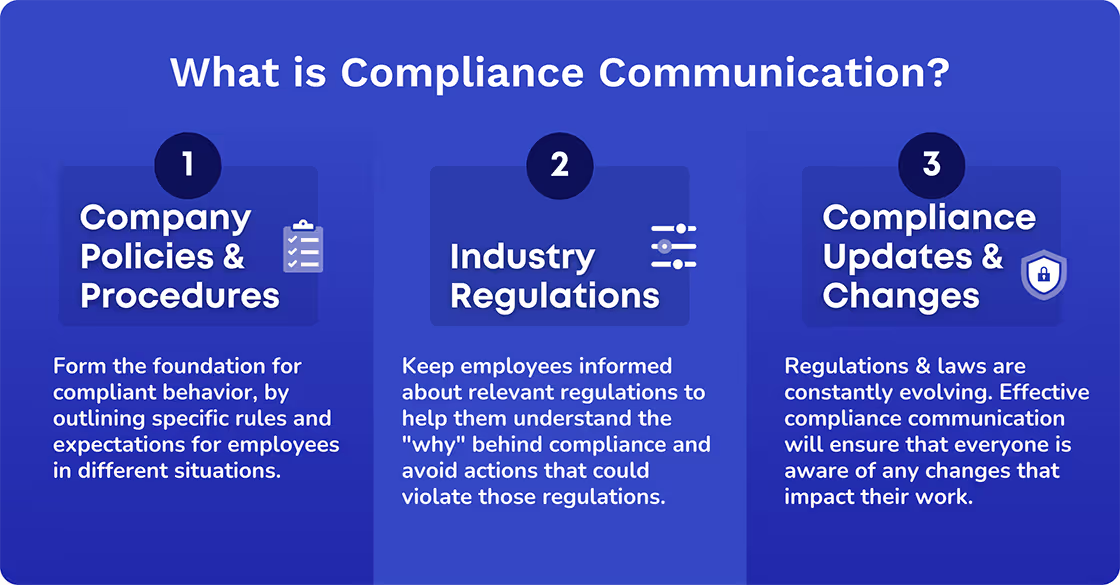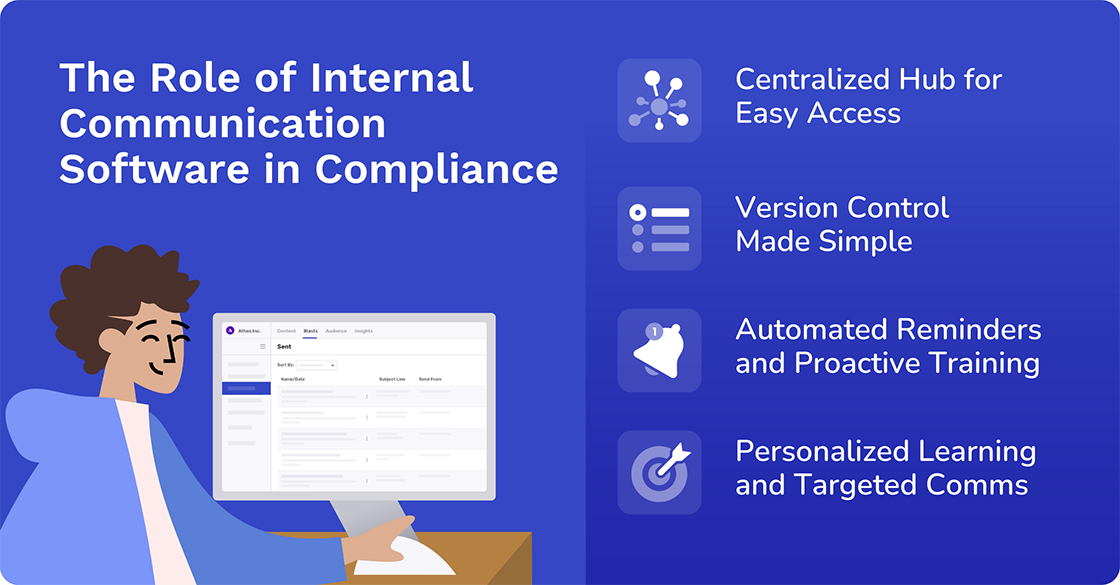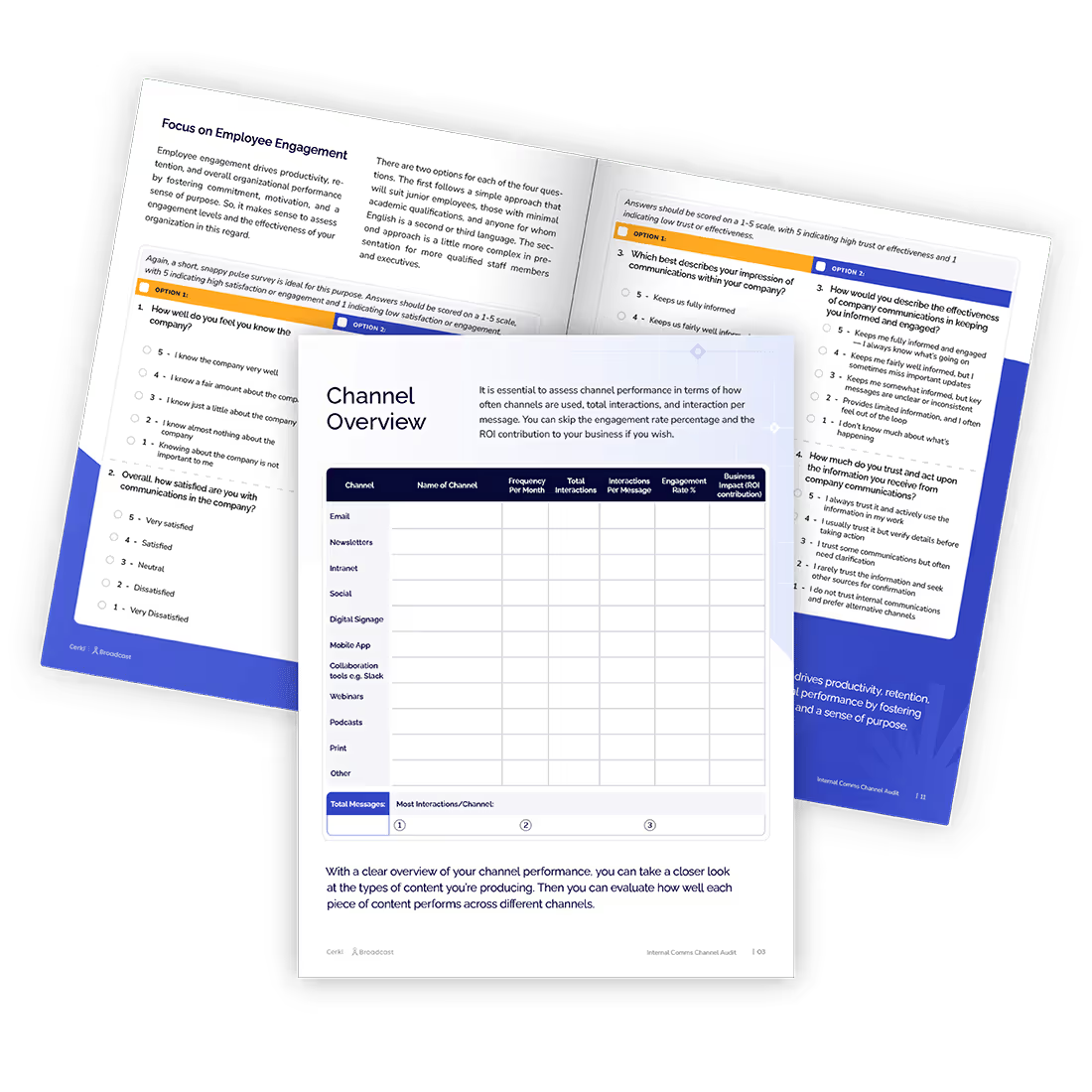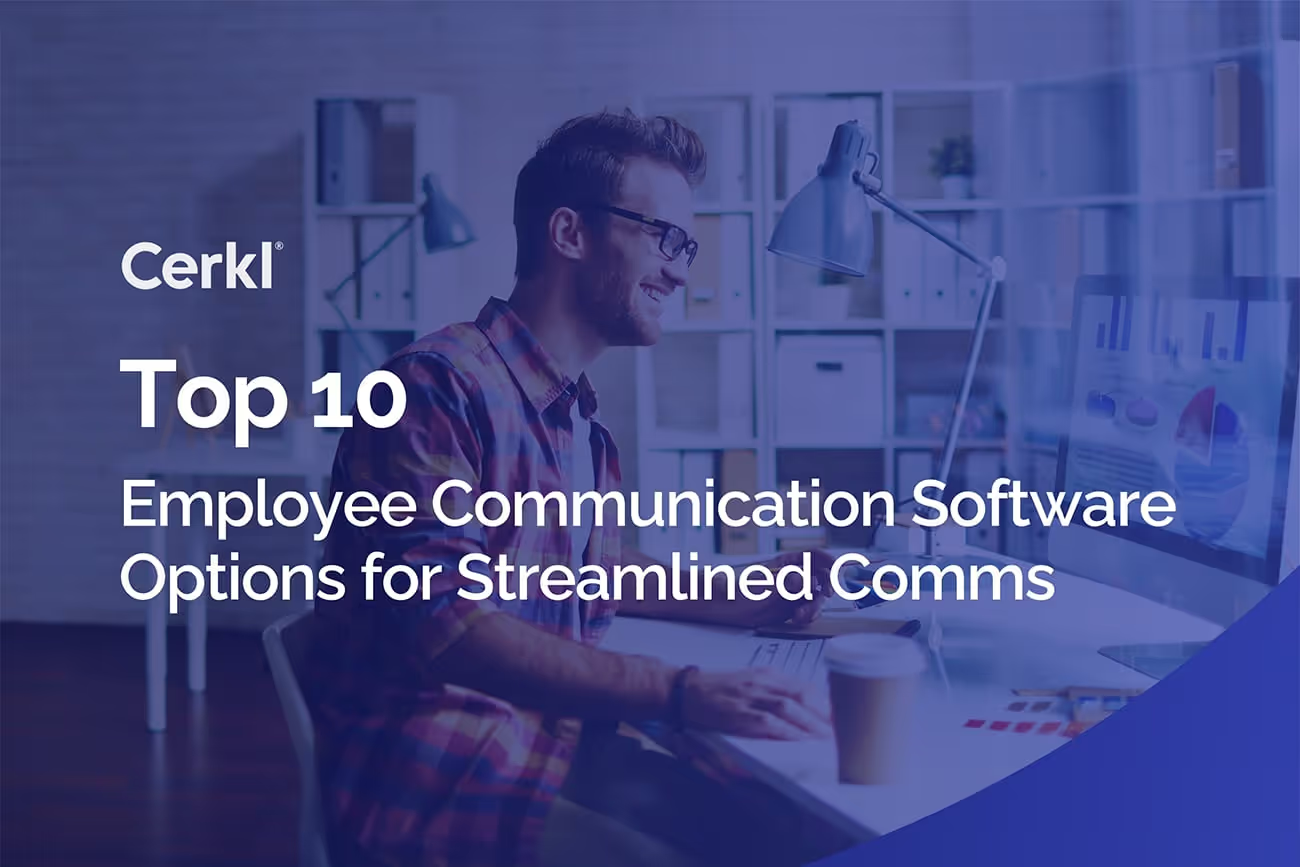Compliance Communication in the Modern Workplace
Compliance communication isn’t always at the top of people’s minds, but it should be in any organization. Here’s why.

.avif)
Audit Your Internal Communications
Strategy is an important component of internal communications. Ensure you’re communicating through the right channels at the right frequency with our Internal Communications Channel Audit worksheet.
Access NowIt is critical to ensure that your organization adheres to comprehensive compliance standards. That’s why compliance communication - the process of effectively conveying information, policies, and guidelines to ensure that an organization and its employees adhere to legal and regulatory requirements - is so important. However, achieving effective compliance communication can be an enormous challenge.
We are going to explore the importance of compliance communication, the challenges traditional methods face, and how internal communication software can revolutionize your approach. But first, let’s look at some global trends.
Global Trends and Challenges
Bryter, an international full-stack development platform for legal, compliance, and procurement, has identified the top challenges compliance leaders are facing in 2024. They have also pinpointed five top trends in risk and compliance. These, they say, will help organizations across the board meet and beat the compliance challenges they face.
- Seize the opportunity to use artificial intelligence (AI) and automation. If you don’t, you will face additional risks in a regulatory landscape that is increasing in scope and complexity.
- Prepare yourself for global AI regulations. They warn that not everything about AI is going to be positive. Regulators are already addressing the fundamental rights and safety risks of AI systems.
- Deal with cybersecurity threats with continuous compliance monitoring.
- Be ready for corporate sustainability due diligence directives. The EU has already produced a legal framework for AI, and President Biden has issued an Executive Order on Safe, Secure, and Trustworthy Development of and Use of Artificial Intelligence.
- Identifying that compliance has become more complex but organizations have less budget, they highlight the need to build better compliance programs with less.
Mercer’s Global Talent Trends 2024 report, Workforce 2.0 Unlocking human potential in a machine-augmented world, identifies Generative AI (Gen AI) as a huge challenge.
“Changing not only how people work but the work experience itself, Gen AI has been met with equal measures of unease and excitement. Will it produce a real productivity lift? Can the increased risk exposure be effectively managed, and is it worth it?”
Mercer
Perhaps unsurprisingly, the report states that 50% of C-suite executives plan to continue investing in technologies supporting governance and regulatory compliance in 2024. There’s no change here, though. The report shows that 50% have been committed to this investment for the past three years (2021-2023). This shows that compliance is vital.
What is Compliance Communication?
Compliance communication is a strategic and ongoing process of conveying compliance-related information to all your stakeholders, most importantly your employees. This information can include:
- Company policies and procedures: This forms the foundation for compliant behavior, outlining specific rules and expectations for employees in different situations.
- Industry regulations: Keeping employees informed about relevant regulations helps them understand the "why" behind compliance and avoid actions that could violate those regulations.
- Compliance updates and changes: Regulations and laws are constantly evolving. Effective compliance communication will ensure that everyone is aware of any updates or changes that impact their work.

In essence, compliance communication is a two-way street. It's not just about disseminating information. It's also about creating an open dialogue where employees can ask questions, raise concerns, and report potential compliance issues. Ultimately, you need to develop a sound, well-considered compliance communication strategy using effective communication channels and compliance messages.
Free Internal Comms Audit Template to Improve Engagement
Upgrade your company’s internal comms to enhance employee communication

Download Free
Why is Effective Compliance Communication Important?
Strong compliance communication offers a multitude of benefits for your organization. By prioritizing effective compliance communication, organizations can minimize risks, enhance their reputation, and promote a culture of compliance together with ethical business practices.
Prevents Non-Compliance and Encourages a Culture of Compliance
Perhaps the most important reason for compliance communication. Clear communication helps employees understand what is expected of them, reducing the risk of non-compliance and potential fines, penalties, or reputational damage. Additionally, effective compliance communication fosters a culture of compliance, where employees understand the importance of adhering to laws, regulations, and industry standards.
Reduced Risk of Non-Compliance and Fines
Compliance communication helps identify and mitigate risks, ensuring that organizations are better prepared to respond to compliance issues and minimize potential harm.
Non-compliance can lead to hefty fines, reputational damage, and legal repercussions. Effective compliance messages keep employees informed about the latest regulations and company policies as well as those that have been in place historically. This helps employees avoid actions that could violate those standards. By empowering employees to make compliant decisions, you significantly reduce the risk of costly mistakes and legal issues.
Increased Employee Awareness and Engagement
Many compliance communication programs fail to go beyond simply informing employees of the "what" – the rules and regulations. However, truly effective communication delves into the "why." When employees understand the rationale behind compliance measures, they're more likely to be engaged and actively participate in upholding those standards.
A good compliance communication strategy with clear communication channels promotes transparency and accountability. This will ensure that employees understand their roles and responsibilities in maintaining compliance.
Improved Company Culture and Ethics
A strong culture of compliance goes beyond just following the rules. It's about creating an environment where ethical behavior is valued and expected. Effective communication plays a crucial role in achieving this. By fostering open communication about compliance, you encourage employees to ask questions, report concerns, and act with integrity. This transparency builds trust within your organization and lays the foundation for a strong ethical culture.

Challenges of Traditional Compliance Communication
Unfortunately, traditional methods of compliance communication often fall short. Here's why.
Information Overload and Employee Disengagement
Employees are bombarded with emails and therefore they often skim content. Dense policy manuals gather dust on desktops, leading to missed key details and a general sense of disengagement with compliance information.
Difficulty Keeping Up with Regulations
Regulations are constantly evolving, including worker exposure guidelines, and static policy manuals quickly become outdated. This creates a risk that employees are operating under outdated information, potentially putting the organization at risk.
Maddy Rieman, Head of Customer Success at Cerkl points out that any company having employees based in Europe or California must abide by the General Data Protection Regulation (GDPR) or the California Consumer Privacy Act (CCPA). However, even though these two laws are for specific regions, they touch a large set of companies.
“Both CCPA & GDPR are both seen as the new ‘standard’ of privacy policy and protection. So, even if a company doesn’t have employees in those regions, at times they still require those same levels of expectations for any vendor because it’s the ‘new standard.’ More than 80% of our existing customers (particularly on the prospect/sales side), ask about our compliance with both of these regulations and how our solutions ensure they are upholding the regulations for their employees.”
Maddy Rieman
If you’re wondering, Cerkl Broadcast is fully CCPA- and GDPR-compliant.
Inconsistent Messaging and Lack of Transparency
Reliance on emails can lead to inconsistent messaging across departments. Unclear communication and lack of transparency can create confusion and misinterpretations, jeopardizing compliance efforts.
In its 2024 Retention Report, Work Institute points out that from 2021 to 2023 there was close to a 100% increase (3.1% in 2021 to 6% in 2023) in the number of compliance reports from employees leaving companies.
“One potential factor contributing to this increase may be a lack of sufficient awareness or training among employees regarding compliance policies and fraud detection procedures.”
Work Institute
Traditional methods simply can't keep up with the dynamic nature of compliance. They fail to engage employees, struggle to adapt to changing regulations and leave room for miscommunication.
The key, says the Work Institute, is education. Without it, “employees may inadvertently violate policies or fail to recognize fraudulent activities, leading to an uptick in reported incidents.”
Free Internal Comms Audit Template to Improve Engagement
Upgrade your company’s internal comms to enhance employee communication

Download Free
How to Develop an Effective Compliance Communication Strategy
It’s not difficult to optimize a compliance communication strategy.
Content
Information supplied in compliance messages can appear dense and complex. To avoid this, use plain language, avoid jargon, and break down information into easily digestible chunks. Bullet points, numbered lists, and short sentences will improve readability.
Furthermore, compliance communication doesn't have to be dry and boring. Use storytelling tactics, real-world examples, and visuals including infographics and videos. This will help to grab employee attention and make information more relatable.
Automatic Data Processing, Inc. (ADP) is a U.S. provider of human resources management software and services. They strongly advise that messaging should be clearly understandable by a wide audience, not just HR professionals. Furthermore, it should empower employees to speak their minds if they spot suspicious activity.
Don't just tell employees what to do. Explain why compliance matters. Frame compliance in terms of its benefits for the organization, the industry, and even society as a whole. Show them how it matters to them.
Frequency
Regular communication is crucial, but bombarding employees with information overload can be counterproductive. Develop a communication calendar that balances the need for updates with employee bandwidth. Consider a mix of channels and message types including monthly email newsletters, quarterly webinars, and possibly short daily reminders.
Don't wait for a crisis to communicate compliance updates. Be proactive in informing employees about any changes in regulations or company policies.
Accessibility
Employees have different communication preferences. Offer compliance information through a variety of channels, including email, internal communication platforms, your company intranet, and mobile apps.
Ensure your communication materials are accessible and user-friendly on all devices and a range of communication channels, from desktop computers to tablets and smartphones. This allows employees to access compliance information on the go, when they need it most.
If your workforce is multilingual, consider offering compliance information in multiple languages to ensure everyone understands their obligations.
Targeting
Don't send generic compliance messages to everyone. Tailor your communication to address the specific needs and roles of different departments or employee groups. For example, the finance team might need more in-depth information on anti-bribery regulations, while the marketing team will be more likely to benefit from guidance on data privacy laws.
Consider including interactive elements in your communication, such as quizzes or polls, to assess employee understanding and identify areas where additional training might be needed.
Metrics and Feedback
Monitor key metrics such as completion rates for training modules, open rates for email communications, and employee participation in compliance discussions. This data will help you gauge the effectiveness of your communication strategies.
Actively solicit feedback from employees on your compliance communication efforts. Use surveys, focus groups, or anonymous suggestion boxes to understand what's working well and identify areas for improvement. This feedback loop allows you to continuously refine your approach and make sure your communication resonates with your audience.

The Role of Internal Communication Software in Compliance
Traditional methods leave a lot to be desired when it comes to compliance communication. Thankfully, employee communication software offers a powerful and dynamic solution, transforming the way you keep your employees informed and engaged.
When you create a compliance communication strategy or rethink an existing one, these are elements to consider.
Centralized Hub for Easy Access
Imagine a single, user-friendly platform housing all your compliance materials – policies, procedures, FAQs, training modules – readily accessible to everyone in the organization. Internal communication software acts as this central hub, eliminating the need for employees to hunt down information in scattered emails or outdated manuals.
Version Control Made Simple
Regulations and company policies are constantly evolving. Internal communication software streamlines content management with a centralized repository. This ensures everyone has access to the latest versions of compliance documents, eliminating the risk of outdated information hindering compliance efforts. Version control features track changes and revisions, providing a clear audit trail for your compliance program.
Automated Reminders and Proactive Training
No more relying on employees to remember compliance training deadlines. Internal communication software automates reminder notifications, ensuring everyone stays on top of their training obligations. The software can also facilitate automated training delivery, making it easier than ever for employees to complete their training modules on their own time.
Personalized Learning and Targeted Communication
A one-size-fits-all approach to compliance communication just doesn't work. Internal communication software allows you to personalize learning experiences based on an employee's role and department. Employees receive targeted communication relevant to their specific needs, ensuring they understand the compliance requirements that directly impact their work. This targeted approach fosters deeper engagement and a more comprehensive understanding of compliance across the organization.

How Cerkl Can Help Maintain Compliance in Communication
Cerkl Broadcast helps maintain compliance in communication by providing a central hub for communication. MyNews allows you to communicate clearly with employees about the security issues that affect them. It also offers features such as Audience Manager, which helps create custom segments to deliver relevant communications to all departments and teams, at scale. This ensures that all employees are receiving the information they need to stay compliant.
Additionally, Cerkl Broadcast offers real-time analytics, which allows you to see who is engaged with your internal communications and who is not. This allows you to identify any areas where there may be gaps in compliance knowledge and take steps to address them. Furthermore, Broadcast is fully GDPR and CCPA compliant. In addition, Broadcast is also fully VPAT compliant. So, when it comes to privacy and accessibility, you can rest easy and get on with your core business.
What’s Next?
Cerkl has a great way for you to assess your internal communications strategy. Our internal communications audit — which is completely free of charge — will help you review your existing strategy and evaluate the effectiveness of the tools you are currently using. It’s an essential first step in ensuring that your compliance communication strategy is on track — or not!

Free Internal Comms Audit Template to Improve Engagement
Upgrade your company’s internal comms to enhance employee communication
Download Free
FAQ
What is compliance communication? Compliance communication is the way companies explain rules and regulations to their employees, investors, customers, and other stakeholders. It helps everyone understand what they need to do to follow the law and avoid risks. Effective compliance communication ensures that all parties understand their roles and responsibilities in maintaining compliance with laws, regulations, and industry standards.
How do you communicate with compliance? To communicate with compliance, organizations should establish clear communication channels such as regular training sessions, policy updates, and reporting mechanisms. This approach will ensure that all employees and other stakeholders are informed and aligned with compliance requirements. This can be achieved through various methods, including in-person training, online modules, and regular updates via email or intranet platforms.
What are the best practices for compliance communication? Best practices for compliance communication include making information easily accessible, using clear and concise language, providing regular updates and training, and encouraging a culture of transparency and accountability. Additionally, organizations should establish a system for reporting compliance concerns, conducting regular audits and risk assessments, and continuously monitoring and evaluating the effectiveness of their compliance communication strategy.









